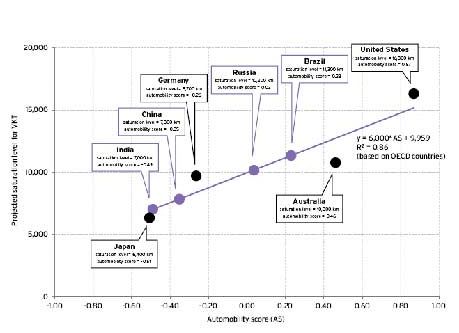Also discussed here: New Study Predicts Vehicle Travel Saturation Levels (Planetizen, Jul. 27, 2014)
Today we review a RAND report that examines and predicts car use in developed (Germany, Australia, Japan) and developing countries (Brazil, Russia, India and China), using eight factors that contribute to car use (demographics, income, geography, fuel price, alternatives, vehicle infrastructure and degree of car culture). Results indicate the most significant predictors of car use are car infrastructure and spatial dispersion leading to sprawl, not as one might expect, fuel price, availability of public transit or income, noting that Japan with the same income has ¼ the car use of the USA. The question is whether large industrial countries just beginning to embrace car use, such as China, will follow the USA or Japan (the authors predict the latter). Interestingly, in response to climate change concerns, the authors note that public policies aimed at reducing carbon fuel use and new technologies may well alter predictions made with the assumptions made with this model.

Key Quotes:
“The report …identifies various factors that affect motor vehicle ownership and use, including demographics (the portion of residents who work), incomes (which is the primary factor considered in previous studies), geography (density and travel distances), vehicle infrastructure (road and parking facility quality and price), fuel price, vehicle ownership policies (such as vehicle taxes and registration fees), quality of alternatives to driving, domestic oil and vehicle production industries political influence, and the favorability of car culture (whether popular culture and consumer attitudes favor automobile travel over other modes)”
“although motor vehicle ownership and use tend to increase as incomes increase from very low to moderate, at high incomes they tend to saturate, and the level of saturation depends significantly on public policies… at the same average level of income, people in Japan travel about one-third the number of kilometers (per capita) that people in the United States do.. 4,000 annual kilometers in Japan, 7,000 annual kilometers in Germany, 10,000 annual kilometers in Australia, and 15,000 kilometers in the United States.”
“one country might move quickly into personal vehicle ownership and thus higher rates of driving when rising income levels make vehicles affordable to a large number of households. Another country might experience more gradual growth in travel by personal vehicle over many decades. A third country might be slower to adopt personal vehicle ownership because existing travel modes already meet mobility needs or because policies limit vehicle purchases or vehicular travel.”
“Lack of Alternatives to Driving.. Australia’s largest cities are served by rail systems, including the world’s largest streetcar network, in Melbourne…Fifteen percent of Australians report having no access to transit, while 33 percent have “easily available” access. Germany has a large supply of public transport infrastructure, including rail lines dating back to the early 1900s.. In the late 1960s, the West German government instituted a fuel tax, in part to fund larger public transport projects…alternatives to driving in the United States varies not only by city but also within urbanized areas. Essentially all cities, even small ones, operate bus systems, but many of these systems provide very limited services and function as social services provided to elderly, disabled, or low-income patrons. Most large and medium-sized cities have rail systems but, in large portions of those urbanized areas, service is infrequent or nonexistent.”
“The presence of oil is considered an indirect factor, in that the government of a country with plentiful oil may encourage consumption to help a major industry (as in the United States). It may also encourage a country with little or no domestic production to promote energy-efficient transportation modes (as in Germany or Japan).”
“Among the nine factors identified as influencing mobility in developed countries, two factors—car infrastructure and spatial dispersion—were identified as most significant. Lower average urban densities stimulate greater auto use, a relationship we see clearly in the much higher motorization rates of Australia and the United States during their motorization periods.”
“the need to control GHG emissions or seismic changes in travel patterns as a result of new technologies, may become more important than the factors we have considered here”









No comments:
Post a Comment